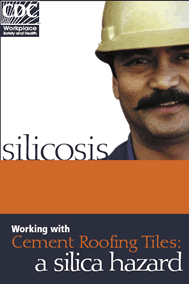
 |
|||
|
NIOSH Publication No. 2006-110:Silicosis - Working with Cement Roofing Tiles: A Silica Hazard |
2006 |
|
Although respirable silica is a recognized health hazard in the construction industry, only recently has this exposure been documented in roofers. NIOSH has measured respirable silica levels up to four times the recommended exposure limit around roofers cutting cement products such as when roofing tiles are cut during the installation process. This cutting generates clouds of silica-containing dust. Respirable silica exposure may also occur when blowers or dry sweeping methods are used to clean the roof. This practice can produce large silica-containing dust clouds. NIOSH does not recommend this practice. Anyone who inhales dust generated by cutting cement tiles or cleaning the residue will be exposed to respirable silica, placing them at risk for developing silicosis. What is Silicosis?Silicosis is a lung disease caused by breathing dust that has silica in it. The term “respirable silica” is used for silica particles that are small enough to be inhaled and deposited in the deepest parts of the lung. If workers inhale too much respirable silica dust, it causes scar tissue to develop in the lungs, resulting in silicosis. Lung damage may be permanent and disabling and may lead to death. There is no cure for silicosis, but it can be prevented. Symptoms of SilicosisSymptoms of silicosis may include
These symptoms can become worse over time. It is important to see a doctor if you have these symptoms. Be sure to tell your doctor about your job and any silica exposures, so he or she can consider silicosis as a possible cause of your symptoms. The Facts
Taking Steps to Protect Workers
better understand which tasks in tile roofing may expose roofers to
silica dust, and NIOSH is working with roofers, roofing contractors, tile manufacturers, and other interested parties to identify and evaluate the effectiveness of engineering controls for cutting concrete roofing tiles such as: Wet cutting methods (water spray or mist) Cutting station on the ground to reduce exposure of coworkers Using RespiratorsUntil respirable silica exposures can be eliminated or reduced below current guidelines, a respirator program should be established. Steps for implementing a respirator program include:
The National Institute for Occupational Safety and Health (NIOSH) works to assure safe and healthy conditions for workers through research, education and training in occupational safety and health. For more information about silica health effects and prevention methods contact us at: NIOSH http://www.cdc.gov/niosh | 
|
||||||